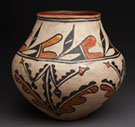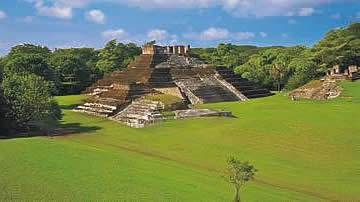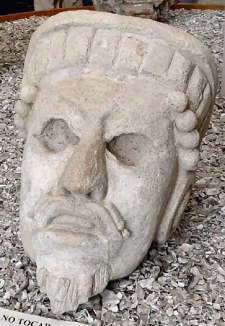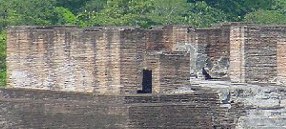


The Mysteries of Comalcalco
 By Logan Hawkes
By Logan Hawkes
Archaeologists are still trying to determine why this Olmec-Mayan site was built with kiln-fired bricks similar to those used in building Rome...
The Olmec-Mayan ruins at Comalcalco, near the modern city of Villahermosa in Tabasco State, are more than a small mystery to archaeologists and other researchers who are studying the unique architectural style of the ancient city. For one, other Meso-American ruins of the region, indeed all the ancient world of the Maya, were built using hand carved limestone blocks -- not bricks.
But the mystery deepened when researchers discovered that when an oyster-base mortar used to bind the bricks was removed, it revealed various odd markings on the back of the bricks, including what is believed to be the brick makers fingerprints.
But it is the strange figures carved into the bricks that are most perplexing to archeologists. Pictured at the right is a comparative illustration that captured the attention, and imagination, of researchers. The symbols in the first six columns (from left to right) in the illustration are mason symbols from Roman bricks. The symbols in the six columns on the right were discovered behind the bricks excavated at Comalcalco. They appear to be almost identical.
 Further complicating the issue, whether by design or coincidence, the bricks have Roman-like architectural measurements and the building structures sport Roman-like architectural features. Further deepening the mystery is the discovery of what may well be a Roman figurine, leading some to speculate that there may have been a Roman-Christian presence in the Americas a thousand years before the arrival of Columbus.
Further complicating the issue, whether by design or coincidence, the bricks have Roman-like architectural measurements and the building structures sport Roman-like architectural features. Further deepening the mystery is the discovery of what may well be a Roman figurine, leading some to speculate that there may have been a Roman-Christian presence in the Americas a thousand years before the arrival of Columbus.
There is an evolving theory that ancient man from the European and Asian continents may have made the Atlantic crossing long before Columbus, bringing with them artifacts and items for trade. According to the theory, the Indian Satavahana Dynasty (circa 200 BC - 200 AD) had extensive trade connections with Rome. As a result, the use of kiln-baked brick had been revived in Hindu Kush and the middle Ganges Valley.
Following this trade development, the Kushana (Yüeh-Chih) people migrated from Hindu Kush to the lower Ganges and developed active maritime trade with Southeast Asia. They were said to have supplied horses to that region and introduced Brahmi script. Roman artifacts are also known to have been traded in that region, probably from these same Kushana, a trading partner with Rome.
Excavation and research at Comalcalco indicates the Maya, if not the Olmec before them, employed a similar fired brick technology, and Indic motifs seem to have been inscribed on some of the bricks. Proponents of theory believe that Brahmi script may have once existed at Comalcalco. Roman-like measurements and Roman architectural features also seem to have been employed at the site. And urn-burials, virtually contemporary with those in India and Southeast Asia, were also discovered at Comalcalco.
 Theorists say elsewhere in the Maya region, Roman-style figurines have emerged, and pre-Columbian horse remains have been excavated. Old World parasites and DNA affinities, the blowgun, bark cloth, and paper manufacturing said to have been unearthed at or near Comalcalco add to the mystery according to supporters of the theory.
Theorists say elsewhere in the Maya region, Roman-style figurines have emerged, and pre-Columbian horse remains have been excavated. Old World parasites and DNA affinities, the blowgun, bark cloth, and paper manufacturing said to have been unearthed at or near Comalcalco add to the mystery according to supporters of the theory.
Of course, mainstream researchers are not quick to embrace the speculation, citing inconclusive and lack of documented evidence. But most will agree that the ruins at Comalcalco are indeed some of the most mystifying pieces of the Mayan puzzle that have been discovered. While much of the architecture is believed akin to structures at nearby Palenque, the art of brick making and many of the design features evident at Comalcalco are singular in the Maya world.
Correspondence to the author should be directed to Loganhawk1@aol.com